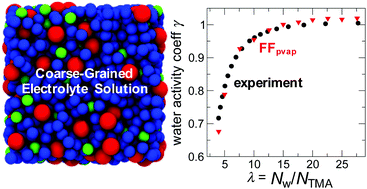Parameterization of a coarse-grained model with short-ranged interactions for modeling fuel cell membranes with controlled water uptake†
Abstract
The design of polymer electrolyte membranes with controlled water uptake is of high importance for high-performance fuel cells, because the water content of the membranes modulates their conductivity, chemical stability and mechanical strength. The water activity aw controls the equilibrium water uptake of a system. Predicting aw of materials is currently a daunting challenge for molecular simulations, because calculations of water activity require grand canonical simulations that are extremely expensive even with classical non-polarizable force fields. Moreover, force fields do not generally reproduce aw of solutions. Here, we first present a general strategy to parameterize force fields that reproduce the experimental aw of solutions, and then implement that strategy to re-parameterize the interactions in FFcomp, a coarse-grained model for hydrated polyphenylene oxide/trimethylamine chloride (PPO/TMACl) membranes in which the TMA cation is attached to the PPO backbone and the Cl anion is in the mobile water nanophase. Coarse-grained models based on short-ranged potentials successfully model fuel cell membranes and other concentrated aqueous electrolyte solutions because electrostatic interactions are highly screened in these systems. The new force field, FFpvap, differs from the original FFcomp only in the parameters of the ion–ion interactions, yet it reproduces aw in TMACl solutions with accuracy within 0.5 and 3% of the experimental value in all the concentration range relevant to the operation of fuel cell membranes. We find that the heat needed to vaporize water in solutions with as little as five water molecules per ion pair is essentially the same as in pure water, despite the strong water–ion interactions and their impact on the water activity. We review the literature to demonstrate that this is independent of the model and a general feature of water solutions. FFpvap reproduces the radial distribution functions and captures well the relative diffusivities of water and ions in the ionic solution as predicted by the reference atomistic GAFF-TIP4P/2005 model, while providing a hundred-fold gain in computing efficiency with respect to the atomistic model. With the backbone fragments inherited from FFcomp, the new FFpvap force field can be used to model hydrated polymer electrolyte membranes and advance the design of fuel cell membranes with controlled water uptake and conductivity.



 Please wait while we load your content...
Please wait while we load your content...